Tarek Ahmed. Reservoir engineering handbook
Подождите немного. Документ загружается.


where B
g
= gas formation volume factor, ft
3
/scf
E
g
= gas expansion factor, scf/ft
3
This chapter presents two approaches for estimating initial gas in place
G, gas reserves, and the gas recovery for volumetric and water-drive
mechanisms:
• Volumetric method
• Material balance approach
THE VOLUMETRIC METHOD
Data used to estimate the gas-bearing reservoir PV include, but are not
limited to, well logs, core analyses, bottom-hole pressure (BHP) and
fluid sample information, along with well tests. This data typically is
used to develop various subsurface maps. Of these maps, structural and
stratigraphic cross-sectional maps help to establish the reservoir’s areal
extent and to identify reservoir discontinuities, such as pinch-outs, faults,
or gas-water contacts. Subsurface contour maps, usually drawn relative
to a known or marker formation, are constructed with lines connecting
points of equal elevation and therefore portray the geologic structure.
Subsurface isopachous maps are constructed with lines of equal net gas-
bearing formation thickness. With these maps, the reservoir PV can then
be estimated by planimetering the areas between the isopachous lines and
using an approximate volume calculation technique, such as the pyrami-
dal or trapezoidal method.
The volumetric equation is useful in reserve work for estimating gas in
place at any stage of depletion. During the development period before
reservoir limits have been accurately defined, it is convenient to calculate
gas in place per acre-foot of bulk reservoir rock. Multiplication of this
unit figure by the best available estimate of bulk reservoir volume then
gives gas in place for the lease, tract, or reservoir under consideration.
Later in the life of the reservoir, when the reservoir volume is defined and
performance data are available, volumetric calculations provide valuable
checks on gas in place estimates obtained from material balance methods.
The equation for calculating gas in place is:
G
Ah S
B
wi
gi
=
-43 560 1,()f
(13- 3)
828 Reservoir Engineering Handbook
Reservoir Eng Hndbk Ch 13 2001-10-24 15:13 Page 828

where G = gas in place, scf
A = area of reservoir, acres
h = average reservoir thickness, ft
f=porosity
S
wi
= water saturation, and
B
gi
= gas formation volume factor, ft
3
/scf
This equation can be applied at both initial and abandonment condi-
tions in order to calculate the recoverable gas.
Gas produced = Initial gas - Remaining gas
or
where B
ga
is evaluated at abandonment pressure. Application of the volu-
metric method assumes that the pore volume occupied by gas is constant.
If water influx is occurring, A, h, and S
w
will change.
Example 13-1
A gas reservoir has the following characteristics:
A = 3000 acres h = 30 ft f=0.15 S
wi
= 20%
T = 150°F p
i
= 2600 psi
pz
2600 0.82
1000 0.88
400 0.92
Calculate cumulative gas production and recovery factor at 1000 and
400 psi.
GAhS
BB
pwi
gi ga
=--
Ê
Ë
Á
ˆ
¯
˜
43 560 1
11
,()f (13 - 4)
Gas Reservoirs 829
Reservoir Eng Hndbk Ch 13 2001-10-24 15:13 Page 829

Solution
Step 1. Calculate the reservoir pore volume P.V
P.V = 43,560 Ahf
P.V = 43,560 (3000) (30) (0.15) = 588.06 MMft
3
Step 2. Calculate B
g
at every given pressure by using Equation 13-1.
pzB
g
, ft
3
/scf
2600 0.82 0.0054
1000 0.88 0.0152
400 0.92 0.0397
Step 3. Calculate initial gas in place at 2600 psi
G = 588.06 (10
6
) (1 - 0.2)/0.0054 = 87.12 MMMscf
Step 4. Since the reservoir is assumed volumetric, calculate the remain-
ing gas at 1000 and 400 psi.
• Remaining gas at 1000 psi
G
1000 psi
= 588.06(10
6
) (1 - 0.2)/0.0152 = 30.95 MMMscf
• Remaining gas at 400 psi
G
400 psi
= 588.06(10
6
) (1 - 0.2)/0.0397 = 11.95 MMMscf
Step 5. Calculate cumulative gas production G
p
and the recovery factor
RF at 1000 and 400 psi.
• At 1000 psi:
G
p
= (87.12 - 30.95) ¥ 10
9
= 56.17 MMM scf
RF =
¥
¥
=
56 17 10
87 12 10
64 5
9
9
.
.
.%
830 Reservoir Engineering Handbook
Reservoir Eng Hndbk Ch 13 2001-10-24 15:13 Page 830

• At 400 psi:
G
p
= (87.12 - 11.95) ¥ 10
9
= 75.17 MMMscf
The recovery factors for volumetric gas reservoirs will range from 80
to 90%. If a strong water drive is present, trapping of residual gas at
higher pressures can reduce the recovery factor substantially, to the range
of 50 to 80%.
THE MATERIAL BALANCE METHOD
If enough production-pressure history is available for a gas reservoir,
the initial gas in place G, the initial reservoir pressure p
i
, and the gas
reserves can be calculated without knowing A, h, f, or S
w
. This is accom-
plished by forming a mass or mole balance on the gas as:
n
p
= n
i
- n
f
(13-5)
where n
p
= moles of gas produced
n
i
= moles of gas initially in the reservoir
n
f
= moles of gas remaining in the reservoir
Representing the gas reservoir by an idealized gas container, as shown
schematically in Figure 13-1, the gas moles in Equation 13-5 can be
replaced by their equivalents using the real gas law to give:
where p
i
= initial reservoir pressure
G
p
= cumulative gas production, scf
p = current reservoir pressure
V = original gas volume, ft
3
z
i
= gas deviation factor at p
i
z = gas deviation factor at p
T = temperature, °R
W
e
= cumulative water influx, ft
3
W
p
= cumulative water production, ft
3
pG
RT
pV
zRT
pV W W
zRT
sc p
sc
i
i
ep
=-
--[( )]
(13- 6)
RF =
¥
¥
=
75 17 10
87 12 10
86 3
9
9
.
.
.%
Gas Reservoirs 831
Reservoir Eng Hndbk Ch 13 2001-10-24 15:13 Page 831
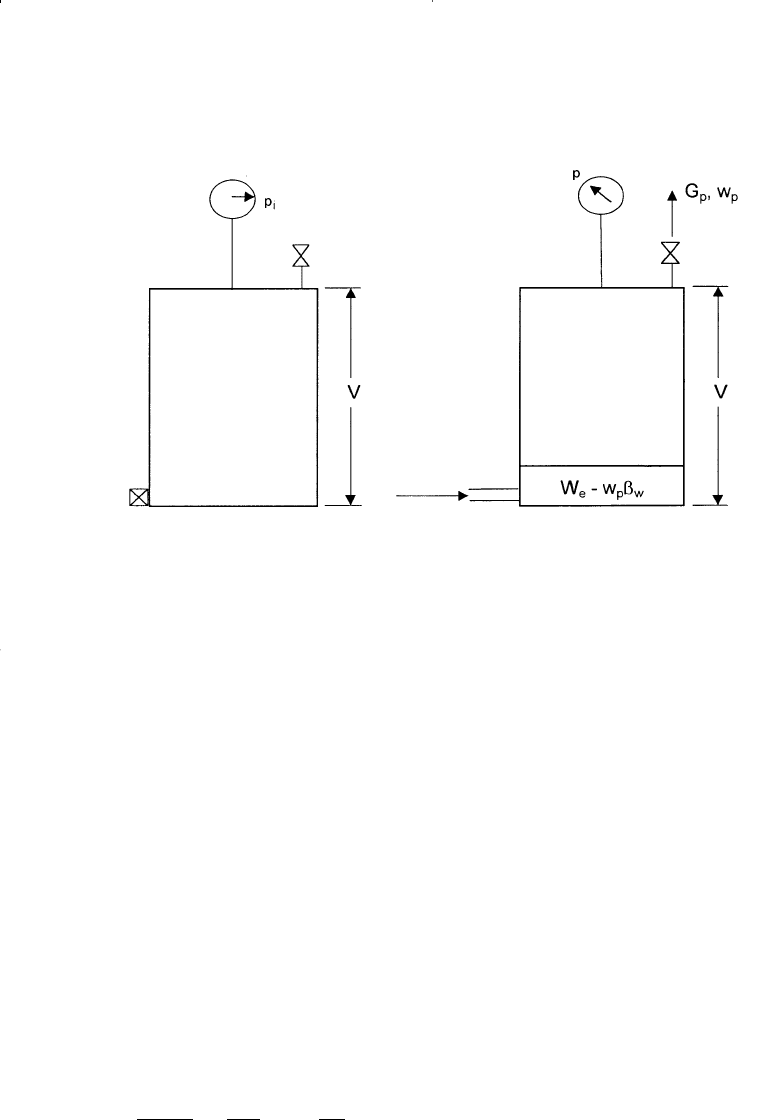
Equation 13-6 is essentially the general material balance equation
(MBE). Equation 13-6 can be expressed in numerous forms depending
on the type of the application and the driving mechanism. In general, dry
gas reservoirs can be classified into two categories:
• Volumetric gas reservoirs
• Water-drive gas reservoirs
The remainder of this chapter is intended to provide the basic back-
ground in natural gas engineering. There are several excellent textbooks
that comprehensively address this subject, including the following:
• Ikoku, C., Natural Gas Reservoir Engineering, 1984
• Lee, J. and Wattenbarger, R., Gas Reservoir Engineering, SPE, 1996
Volumetric Gas Reservoirs
For a volumetric reservoir and assuming no water production, Equa-
tion 13-6 is reduced to:
Equation 13-7 is commonly expressed in the following two forms:
pG
T
p
zT
V
p
zT
V
sc p
sc
i
i
=
Ê
Ë
Á
ˆ
¯
˜
-
Ê
Ë
ˆ
¯
(13- 7)
832 Reservoir Engineering Handbook
Figure 13-1. Idealized water-drive gas reservoir.
Reservoir Eng Hndbk Ch 13 2001-10-24 15:13 Page 832
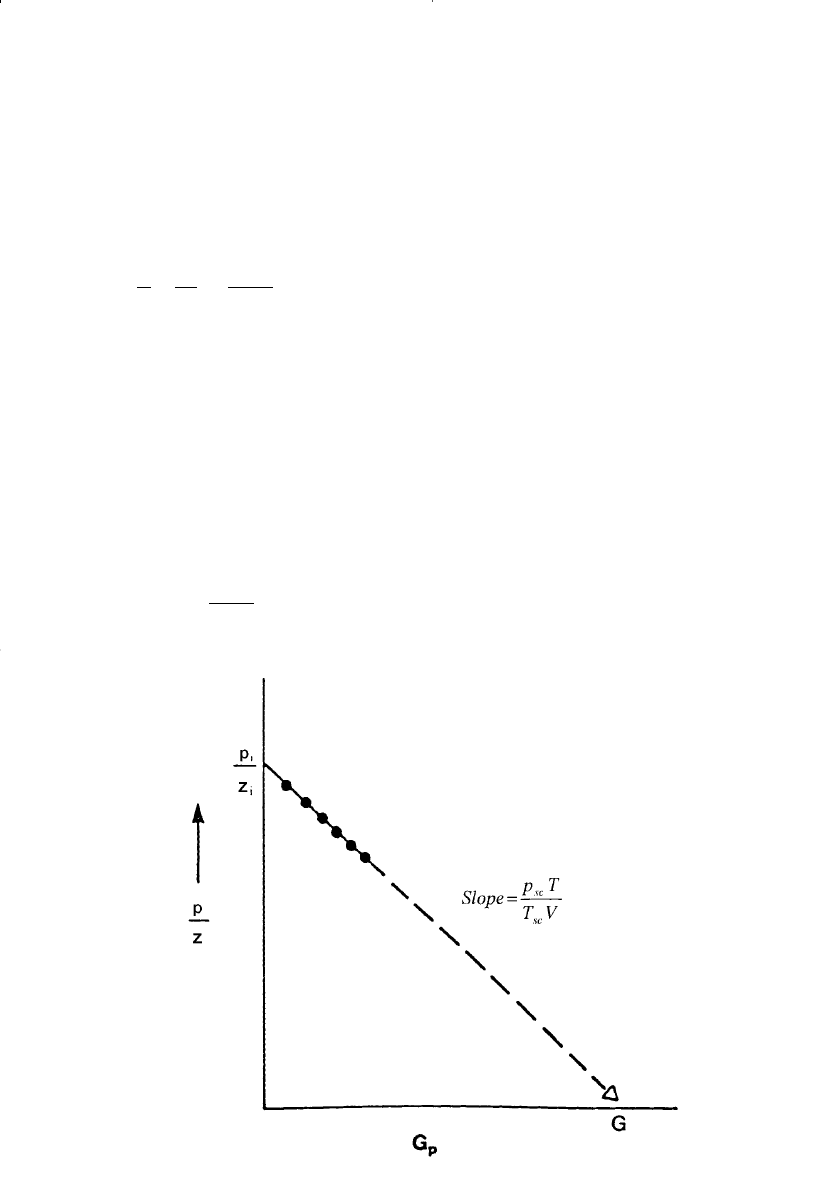
Form 1. In terms of p/z
Rearranging Equation 13-7 and solving for p/z gives:
Equation 13-8 is an equation of a straight line when (p/z) is plotted
versus the cumulative gas production G
p
, as shown in Figure 13-2. This
straight-line relationship is perhaps one of the most widely used relation-
ships in gas-reserve determination.
The straight-line relationship provides the engineer with the reservoir
characteristics:
• Slope of the straight line is equal to:
slope
pT
TV
sc
sc
= (13- 9)
p
z
p
z
pT
TV
G
i
i
sc
sc
p
=-
Ê
Ë
Á
ˆ
¯
˜
(13- 8)
Gas Reservoirs 833
Figure 13-2. Gas material balance equation.
Reservoir Eng Hndbk Ch 13 2001-10-24 15:13 Page 833

The original gas volume V can be calculated from the slope and used
to determine the areal extend of the reservoir from:
V = 43,560 Ah f (1 - S
wi
) (13-10)
where A is the reservoir area in acres.
• Intercept at G
p
= 0 gives p
i
/z
i
• Intercept at p/z = 0 gives the gas initially in place G in scf
• Cumulative gas production or gas recovery at any pressure
Example 13-2
1
A volumetric gas reservoir has the following production history.
Time, t Reservoir pressure, p Cumulative production, G
p
years psia z MMMscf
0.0 1798 0.869 0.00
0.5 1680 0.870 0.96
1.0 1540 0.880 2.12
1.5 1428 0.890 3.21
2.0 1335 0.900 3.92
The following data is also available:
f=13%
S
wi
= 0.52
A = 1060 acres
h = 54 ft.
T = 164°F
Calculate the gas initially in place volumetrically and from the MBE.
Solution
Step 1. Calculate B
gi
from Equation 13-1
B ft scf
gi
=
+
=0 02827
0 869 164 460
1798
0 00853
3
.
(. )( )
./
834 Reservoir Engineering Handbook
1
After Ikoku, C., Natural Gas Reservoir Engineering, John Wiley & Sons, 1984.
Reservoir Eng Hndbk Ch 13 2001-10-24 15:13 Page 834
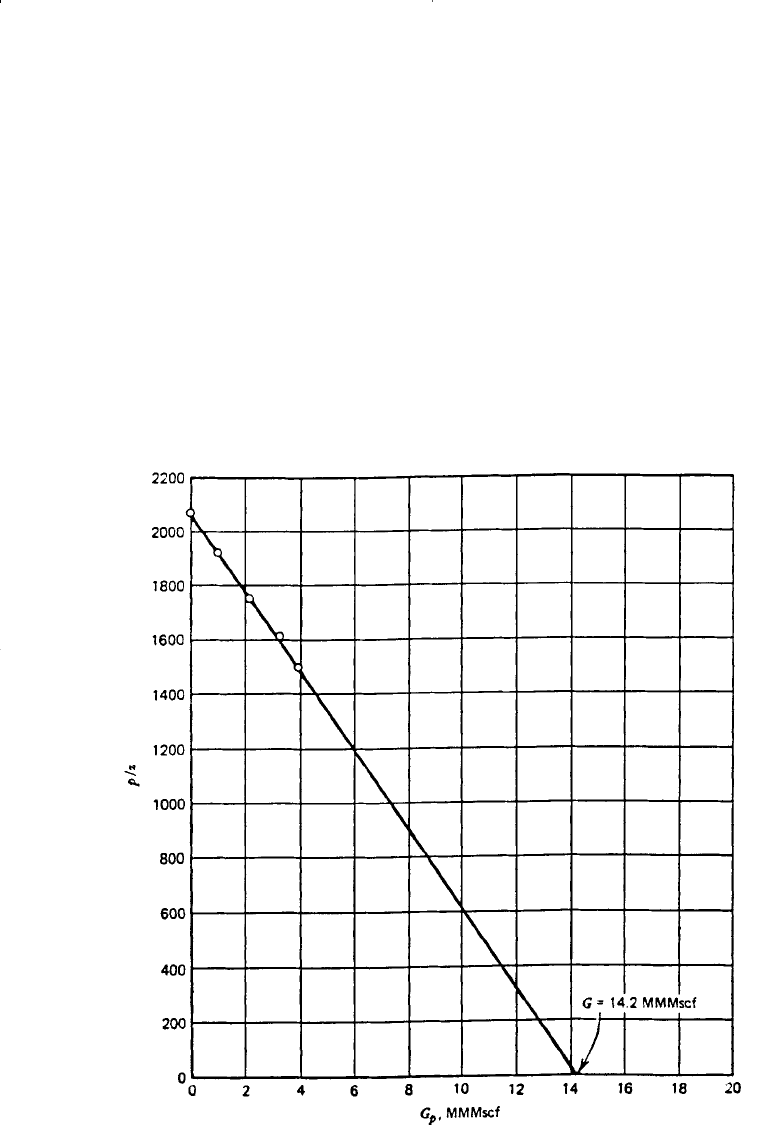
Step 2. Calculate the gas initially in place volumetrically by applying
Equation 13-3.
G = 43,560 (1060) (54) (0.13) (1 - 0.52)/0.00853 = 18.2 MMMscf
Step 3. Plot p/z versus G
p
as shown in Figure 13-3 and determine G.
G = 14.2 MMMscf
This checks the volumetric calculations.
Gas Reservoirs 835
Figure 13-3. Relationship of p/z vs. G
p
for Example 13-2.
Reservoir Eng Hndbk Ch 13 2001-10-24 15:13 Page 835
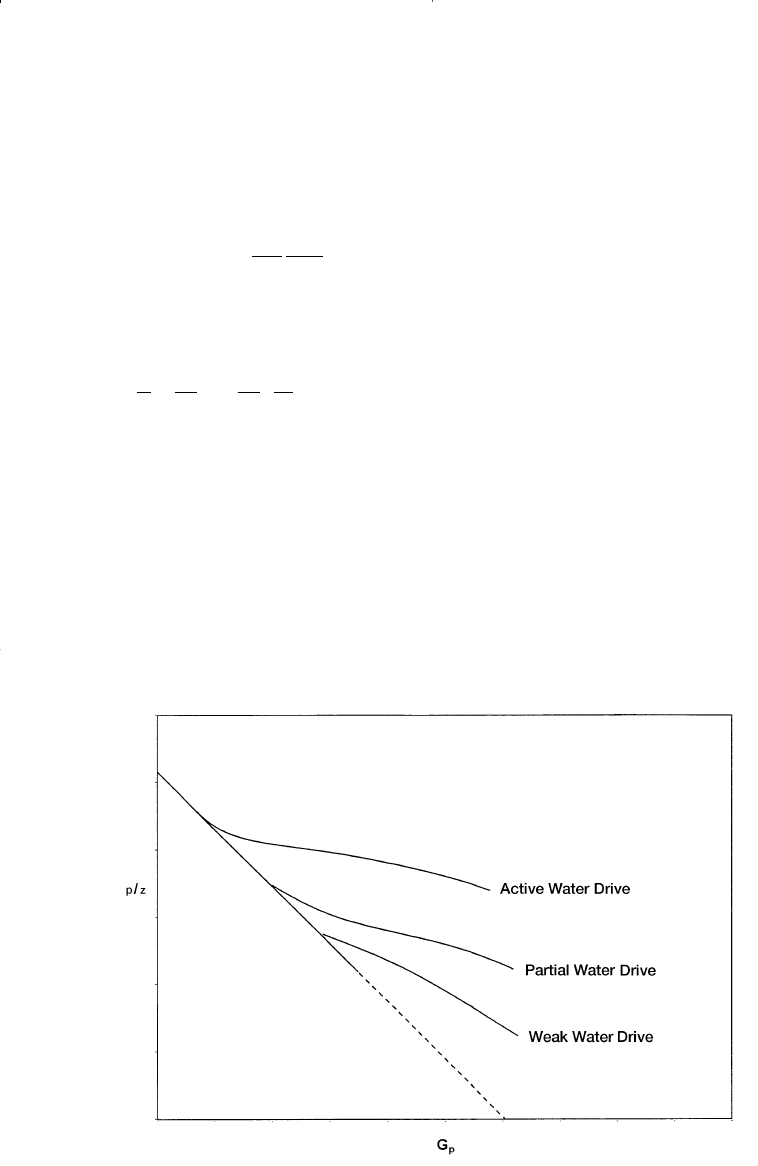
The initial reservoir gas volume V can be expressed in terms of the
volume of gas at standard conditions by:
Combining the above relationship with that of Equation 13-8 gives:
Again, Equation 13-11 shows that for a volumetric reservoir, the rela-
tionship between (p/z) and G
p
is essentially linear. This popular equation
indicates that by extrapolation of the straight line to abscissa, i.e., at p/z =
0, will give the value of the gas initially in place as G = G
p
.
The graphical representation of Equation 13-11 can be used to detect
the presence of water influx, as shown graphically in Figure 13-4. When
the plot of (p/z) versus G
p
deviates from the linear relationship, it indi-
cates the presence of water encroachment.
p
z
p
z
p
zG
G
i
i
i
i
p
=-
Ê
Ë
Á
ˆ
¯
˜
È
Î
Í
˘
˚
˙
1
(13-11)
VBG
p
T
zT
p
G
g
sc
sc
i
i
==
Ê
Ë
Á
ˆ
¯
˜
836 Reservoir Engineering Handbook
Figure 13-4. Effect of water drive on p/z vs. G
p
relationship.
Reservoir Eng Hndbk Ch 13 2001-10-24 15:13 Page 836
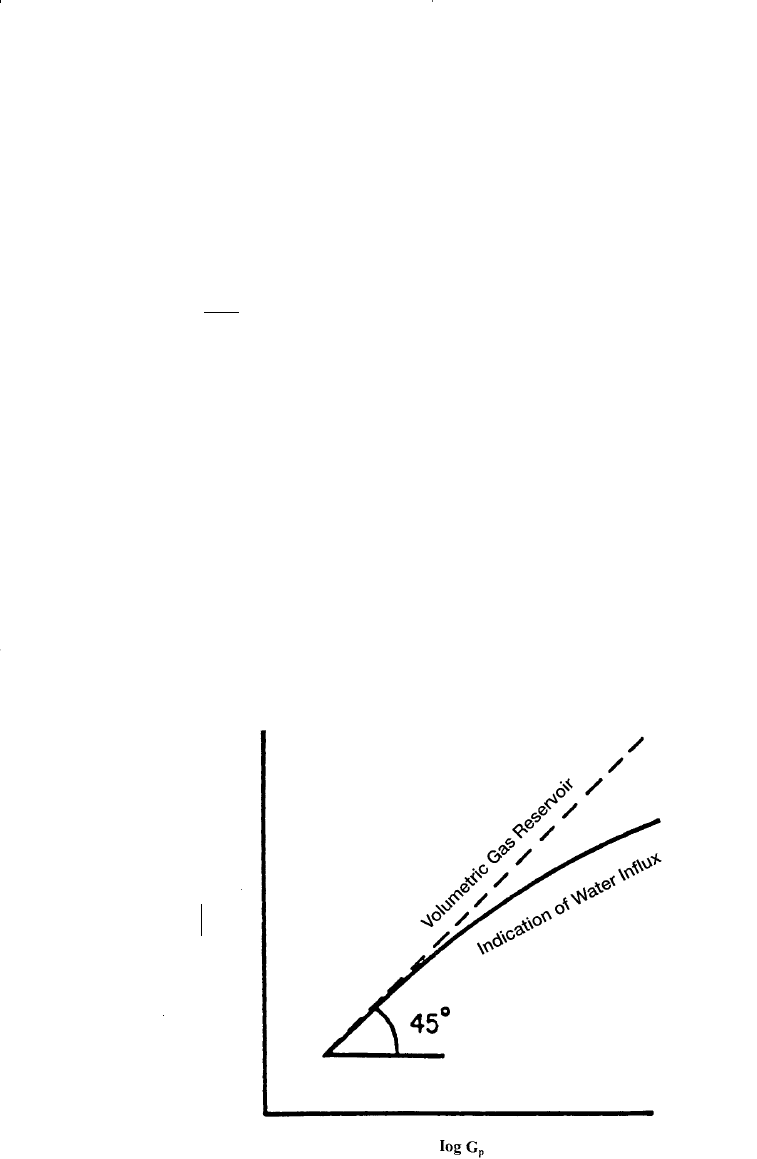
Many other graphical methods have been proposed for solving the gas
MBE that are useful in detecting the presence of water influx. One such
graphical technique is called the energy plot, which is based on arrang-
ing Equation 13-11 and taking the logarithm of both sides to give:
Figure 13-5 shows a schematic illustration of the plot.
From Equation 13-12, it is obvious that a plot of [1 - (z
i
p)/(p
i
z)] ver-
sus G
p
on log-log coordinates will yield a straight line with a slope of one
(45° angle). An extrapolation to one on the vertical axis (p = 0) yields a
value for initial gas in place, G. The graphs obtained from this type of
analysis have been referred to as energy plots. They have been found to
be useful in detecting water influx early in the life of a reservoir. If W
e
is
not zero, the slope of the plot will be less than one, and will also decrease
with time, since W
e
increases with time. An increasing slope can only
occur as a result of either gas leaking from the reservoir or bad data,
log log log1-
È
Î
Í
˘
˚
˙
=-
zp
pz
GG
i
i
p
(13-12)
Gas Reservoirs 837
Figure 13-5. An energy plot.
log 1 –
z
i
p
p
i
z
Ê
Ë
Á
ˆ
¯
˜
Reservoir Eng Hndbk Ch 13 2001-10-24 15:13 Page 837
